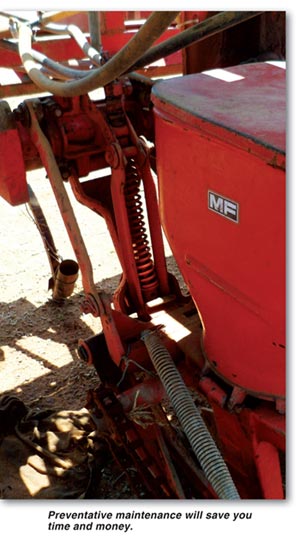October 2015
 During the last couple of months there have been a couple of articles on the maintenance of tractors and some implements in the Pula Imvula. What to do and how to do it was discussed and illustrated.
During the last couple of months there have been a couple of articles on the maintenance of tractors and some implements in the Pula Imvula. What to do and how to do it was discussed and illustrated.
In this article we would like to put the emphasis on the management aspects and the financial implications of the maintenance of assets or rather the irregular maintenance of assets. Assets refer to all types of assets – tractors, vehicles, implements, buildings, and so forth.
The emphasis is on performing preventive maintenance to keep your assets in tip-top working condition rather than to repair when something has broken. There is nothing that prevents deterioration and breakdowns as surely as irregular maintenance. And breakdowns can be very costly should it cause a major delay of planting or harvesting of a crop on time.
How will one go about it to perform regular preventative maintenance? Proper management must be applied by planning, organising, implementing and controlling the process. To manage the process you need information.
First of all make a list of all assets and identify them by numbering them. This list is normally referred to as an Asset Register and was discussed in more detail in an article regarding the management of assets in the Pula Imvula of July 2014.
Once this is done consider and record the service interval required for each asset and indicate the type of service to be done – a full service, light service, check-up, and so forth.
Then draw up a week-by-week, asset-byasset plan for the next year and take into account the seasonal workloads of the vehicles and equipment. In this plan you should then also indicate the detail of the maintenance required and what will be needed – spare parts, paint, cleaning material, building material, and so on.
Naturally this all must be done in writing, manually or per computer and is then the planning function and part of the organising function of management. Then it is up to you to implement the plan on the weekly basis as planned and apply the necessary control. All this will take some time but once you have compiled the plan, it will serve you for many a year to come. Please remember to update this maintenance plan when necessary but at least once a year. This will be part of the control function of management.
The major advantages of doing this effort is that you will be applying regular and preventative maintenance and your work will be organised. You will be doing what is needed to be done on time and the planning will help you to acquire all that is needed in time preventing unnecessary trips to town and saving money and time, and so forth. Furthermore, regular preventative maintenance will save you a lot of money over the long term. As the saying goes, it is better to be penny wise than pound foolish.
Normally to compile a plan for the maintenance of vehicles, tractors, machinery and implements should not be that difficult. However, to plan for the maintenance of the other assets on the farm like buildings, sheds, kraals, fences, water troughs, and so on will be a bit more challenging. However, these assets also need regular preventative maintenance. Buildings need to be painted every five to ten years and gutters to be cleaned once or twice a year. Drain pipes from wash basins, toilets, and baths must be cleaned regularly (once every three months depending on usage). Do not wait till they are blocked which could then lead to a major and costly exercise. These days efficient chemicals are available to clean these pipes on a regular basis within a couple of minutes. See to it that all roof bolts and screws are securely tightened on a regular basis. Just tightening a bolt could save you a lot of money. In other words, you will need to consider the maintenance of these other assets carefully, from a point of view that prevention is better than cure. The principle should also be to do repairs immediately (as soon as possible). To postpone any repairs will in all probability eventually be more costly.
What will be the cheapest: To service your bakkie regularly as prescribed which then includes the changing of the oil regularly, or to never replace the oil and drive the vehicle till the engine seizes and then need a major overhaul? Quite amazing to observe the number of vehicles driven on our roads with smoke bellowing from the exhaust, the probable result of irregular or no oil changes.
A further advantage of planning the maintenance of all assets is that this planning can then also be incorporated into your overall budget or then financial planning for the next year. Decide on or where possible, calculate the estimated cost of all the maintenance and include this information in your budget.
Article submitted by Marius Greyling, Pula Imvula contributor.
For more information, send an email to mariusg@mcgacc.co.za.
Publication: October 2015
Section: Pula/Imvula